 |
| |
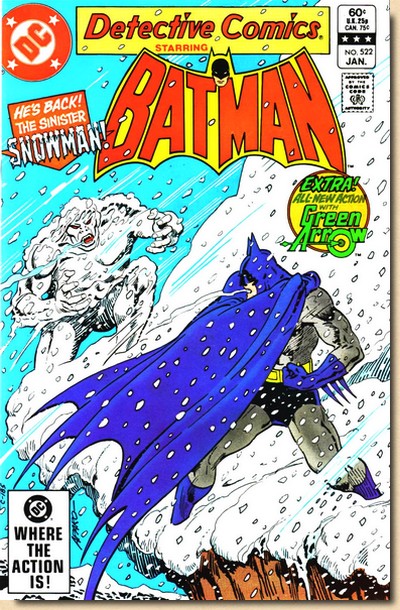 |
|
DETECTIVE
COMICS #522
(JANUARY
1983)
BATMAN
TRAVELS TO TIBET
IRV NOVICK LETS IT SNOW
"Snowblind"
(16 pages)
Cover
pencils - Jim Aparo
Cover inks - Jim Aparo
Cover colouring - Anthony Tollin
Story - Gerry
Conway
Art - Irv Novick
Inks - Pablo Marcos
Colours - Adrienne Roy
Lettering - Ben Oda
Editor - Len Wein (with
Nicola Cuti)
Second
feature - Green Arrow, "Automatic
Pirate!" (7 pages)
Letters page - The Batcave (2
pages)
Preview Coming Comics for titles
on sale 4th November 1982 (1
page)
|
|
|
| |
PLOT SUMMARY
Whilst
thumbing through a magazine in Vicki Vale's office Bruce
Wayne happens to chance upon a most mysterious photograph
- showing a man who should, to the best of Batman's
knowledge, be dead. And yet Bruce is certain beyond a
doubt that he is looking at Klaus Kristin, whose
transmutent genes allowed him to change from his human
form into a yeti - an abominable Snowman - at will.
|
| |
| The problem
Bruce Wayne has in chancing upon this
recent photograph is that - during a
previous encounter - the Darknight
Detective saw Kristin fall into a deep
gorge as Snowman, and he has therefore
believed him to be dead since. In order to
investigate how a man he saw falling to
his death can now be alive and leading
trekking groups in the Himalajas, the
Darknight Detective travels to the remote
icy slopes of Tibet.
Here he enlists the
help of a local guide Chi, and after a
lengthy search, leading him deep into the
barren and blistering white landscape of
the Tibetan mountains, Batman finally does
indeed find Kristin - known to him as the
Snowman. Realizing that he has been
tracked down, he attacks the Batman in
his human form and sends him into the
waters of a lake, but then also saves him
as the Darknight Detective is knocked out
as his head crashes onto a submerged
rock. Misunderstanding the scene, Chi
fires a shot and wounds Kirstin, who then
makes off by swimming out over the lake,
as a reawakened Batman prevents his guide
from firing any more shots at the
fugitive.
|
|
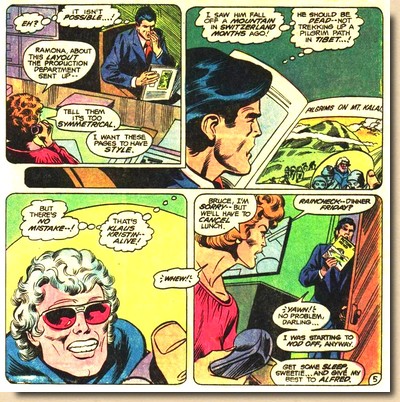 |
|
|
| |
| Puzzled by
Kirstin's motives and baffled by how he must have
miraculously survived the fall the Darknight Detective
had witnessed during their last encounter, the Batman and
Chi venture even deeper into the mountains. |
| |
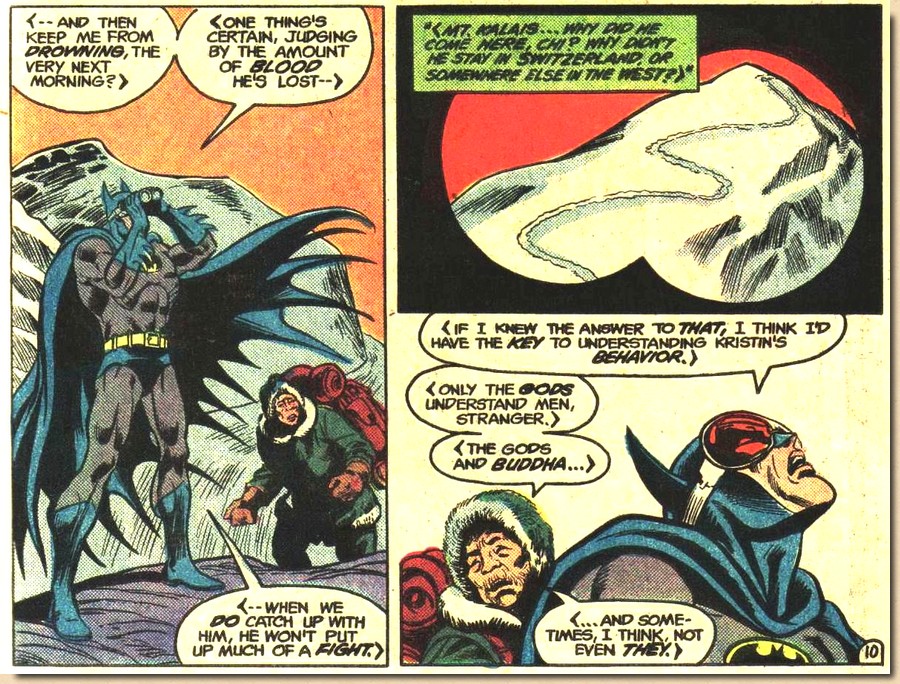 |
| |
| Suddenly, they are attacked by
a huge Snowman who sends the Darknight Detective over the
edge of a narrow path along a snowcapped cliff. Holding
on to a protruding rock outcrop the Batman is rescued by
Chi who throws him a rope and pulls him to safety (and
muses to himself that this is a spectacular story to tell
to his yet to be born grandchildren but one which they
will never believe). |
| |
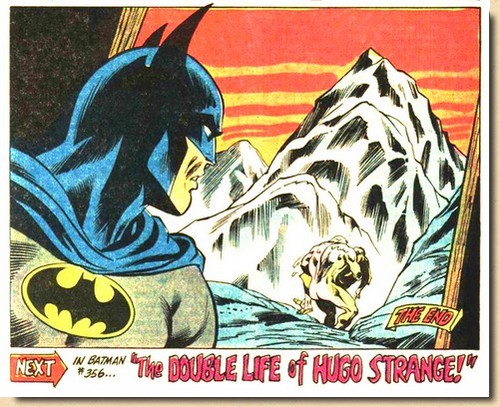
|
|
Batman and
Chi find Kristin in his human
form in a nearby Buddhist shrine.
Wounded and severly weakened from
the gunshot, he tells them that
he has retreated to the Himalajas
after surviving his fall in order
to find peace - and his father.
And when all of a sudden a huge
yeti appears from the shadows of
the shrine, violently attacking
Batman and Chi, they both know
that it was not Kristin who
attacked them earlier on, but
always his father. Holding the
Yeti at bay with a flare gun, the
Darknight Detective wants Kristin
to stand for trial for the
murders he committed previous to
their first encounter, but not
surprisingly, Kristin refuses,
not the least because he is dying
anyway. As he feels that justice
is being served anyway, the
Batman watches as a fading
Kristin - the villain once known
to the Darknight Detective as the
Snowman - is carried away and off
into the big white nothingness of
the Tibetan mountains by his
father...
|
|
|
|
| |
REVIEW & ANALYSIS
Taking a
break from the previous crossover stories between Detective
Comics and Batman, this issue features a
stand-alone story by all levels of definition. Firstly,
Batman does it all alone, without Robin (whose offer to
help the Darknight Detective - possibly even together
with the Teen Titans - Batman declines with little more
than a few words) or Alfred. Secondly, the story takes
place in a setting which could hardly be more removed
from the Batman's archetypal urban hunting ground - the
snow capped mountains of Tibet.
|
| |
| Whether or not the
Batman works outside of the concrete
jungle as character and persona is, as
many things, a matter of taste as well as
the individual plot and story. In the
mid-1970s and early 1980s, writers were
rather fond of taking the Batman on
travels which took him away from his
usual haunts, be it within the US (e.g. Florida) or
even abroad (e.g. Egypt). In
this case, the premise is strong and
generates interest - the mystery of a man
presumed dead but who appears to yet be
amongst the living - but is gradually
brought down to average level. Unless the
reader has a pronounced interest in
yetis, the Snowman proves himself to be
almost like the snow of his Tibetan home:
colourless. Not surprisingly, this
appearance (his second overall) was to be
his last ever in the Batman Universe.
The level of
craftmanship in this issue is generally
high, considering a setting which in many
ways results in the Batman being somewhat
out of his waters (with Gotham's dark
shadows replaced by the Himalaja's
blazingly white snow) and a villain who
raises few, if any, eyebrows. The
storytelling gains added interest from a
lengthy flashback sequence (accentuated
visually by rounded panel corners), and
the artwork is engaging and flows with
the unfolding mystery of Klaus Kristin.
|
|
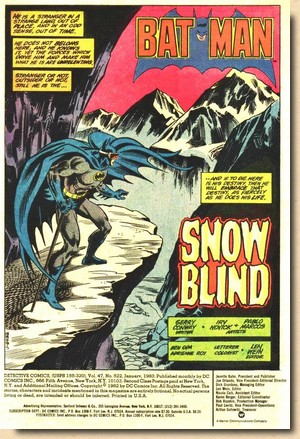 |
|
|
| |
| VERDICT:
CASUAL
READING -
An unusual Batman story in a rather alien setting
for the Darknight Detective, but worth a read as
a done-in-one which provides some momentum from
both story and artwork. |
|
| |
FACTS & FIGURES
"Snowblind"
highlights the Batman's linguistic versatility as he
freely converses with his guide in Chinese throughout the
entire story (hence most of the dialogue being presented
in <square brackets>).
This
Batman feature has not been reprinted in a collected
edition up until now, but at the time was translated and
published in 1983 by German publishing house Egmont Ehapa
as "Schneeblind" in Batman Sonderausgabe
#3 (shortened by one page), and then in May 1984 in Super-Heróis #24 by the
Agência Portuguesa de Revistas.
|
| |
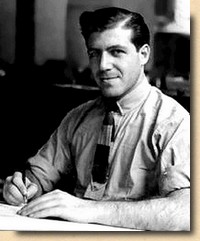 |
|
The
artwork was provided by at the time
veteran Batman artist Irving Novick. Born
11 April 1916, he graduated from the
National Academy of Design in New York
City and, following a brief stunt at the
illustrator's studio of Harry Chesler in
1939, went on to spend almost his entire
career in the comic book industry. Novick was first
hired by MLJ (the predecessor of Archie
Comics) where the first work credited to
him was published in December 1939 in Blue
Ribbon Comics #2. The next month Irv
(as he was called) did the cover and lead
story for Pep Comics #1 which
featured the first adventure of The
Shield - the very first
"patriotic" super-hero who,
scripted by Harry Shorten, worked along
similar lines as the yet to be introduced
Captain America would: by wearing a
costume based on the American flag and
its heraldic symbols. Novick quickly
became MLJ's lead superhero artist,
drawing all their major costumed
characters until the genre was cut back
in favour of the publisher's Archie
titles as superheroes lost favours with
comic book readers after World War Two.
|
|
|
| |
| Starting in 1946 Novick
worked on two syndicated strips for five years (Cynthia
and The Scarlet Avenger). Syndication was the
road to fame and fortune for artists at the time, but
neither of the two strips ever achieved wide circulation,
and as his sporadic work in advertising wasn't proving
reliable either Novick accepted an offer to work for DC
Comics by editor Robert Kanigher (who had worked with Irv
back in the days at MLJ). Being the DC war titles'
editor, Kanigher had Novick draw mostly war stories,
which fitted his style really well, and his work
subsequently appeared in virtually all the DC combat
titles. |
| |
| In
the mid-1960s Novick left the comic book
industry after being offered a full-time
position at the Johnstone-Cushing
advertising agency, but the work didn't
turn out to be what Irv had hoped for. DC
Comics was unhappy about the situation
too, and offered Novick an unprecedented
freelance contract which guaranteed him
the highest artist's rate plus a steady
amount of work. In essence, this meant
that as soon as he has finished a job he
was to immediately receive another
assignment, resulting in a substantial
body of artwork by Irv Novick for DC over
the years. He was switched back
to his superhero roots when Carmine
Infantino took a seat amongst DC
management in 1968 and thus became a
full-time superhero penciller once again,
eventually providing the artwork for most
of DC's top titles of the genre,
including numerous contributions to Batman
and Detective Comics.
Irv Novick
had a substantial part in shaping the
visuals of Batman during the Bronze Age.
Retaining his very own style, he together
with a few other pencillers fleshed out
the popular culture icon look which Neal
Adams had created, and left a lasting
contribution to the hallmark appearance
and visuals of the Darkinght Detective
which even though stemming from the 1970s
and early 1980s still remain iconic to
this day. His pencils had a classic touch
in the best sense of the word, and his
pictorial storytelling was fresh and
dynamic and even made some of the lamer
plots of the Bronze Age look interesting.
|
|
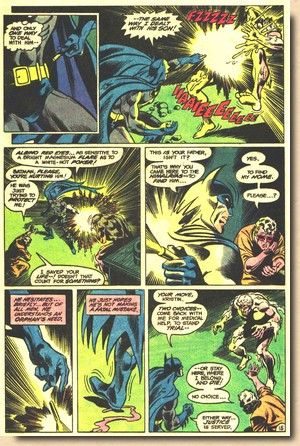 |
|
|
| |
| Irv Novick remained active
as a comic book artist well into his late seventies and
only slowed down when his eyesight began to restrict his
pencilling abilities in the late 1990s. He passed away on
5 October 2004. Hopefully, DC Comics will eventually
release a collected edition of his Batman work as they
have done for other 1970s and 1980s artists - the legacy
of Irv Novick's artwork would certainly merit a hardcover
showcase. |
| |
COMMENTS FROM THE BATCAVE
|
| |
 |
|
"DETECTIVE
522, while not furthering the ongoing plotlines
(...) was an enjoyable issue. (...) Much though I
liked Klaus, I hope he won't be brought
back." (Jeanne Powers, Bristol VA)
"Irv Novick and
Pablo Marcos did such a good job on the art that
I hope they will return some time in the
future." (Dustin Leary, Morehead City,
N.C.)
|
| |
|
|
|

|
| |
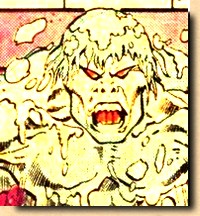 |
|
SPOTLIGHT
ON
THE
SNOWMAN
IDENTITY -
Klaus Kristin
FIRST
APPEARANCE -
Batman #337 (July 1981)
CREATED BY -
Gerry Conway, Roy Thomas &
Jose-Garcia Lopez
CHARACTERIZATION - A
marginal Batman villain based on the
famous Yeti, the "Abominable
Snowman", Klaus Kristin is the
mutant son of a male yeti and a woman
named Katrina Kristin
|
|
|
| |
ORIGIN
Katrina
Kristin travels to the Himalajas as part of a United
Nations expedition to study the regional flora. Separated
from the group in a snowstorm, she is rescued by a
stranger and kept from harm in a cave. She feels drawn to
her rescuer and spends the night in his arms, only seeing
his face the next morning. Two weeks later, Katrina
Kristin is found by another group of mountaineers in a
state of complete and irreversible hysteria and mental
breakdown, claiming that she had been rescued by a yeti,
an abominable snowman. She later gives birth to a son,
Klaus Kristin, whose transmutent genes allow him to
change from his human form into a yeti at will (Batman #337,
July 1981).
|
| |
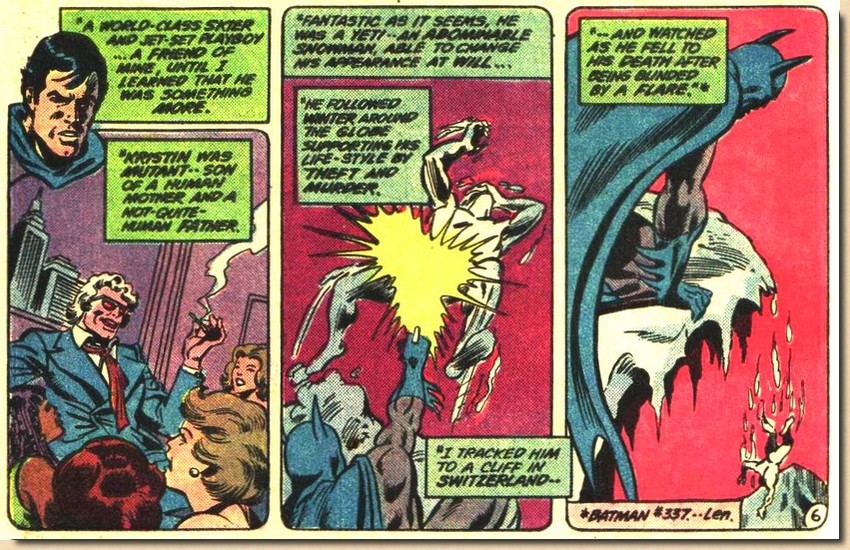
Klaus
Kristin's background is summarized by Gerry Conway and
Irv Novick in Detective Comics #522 (January
1983)
|
| |
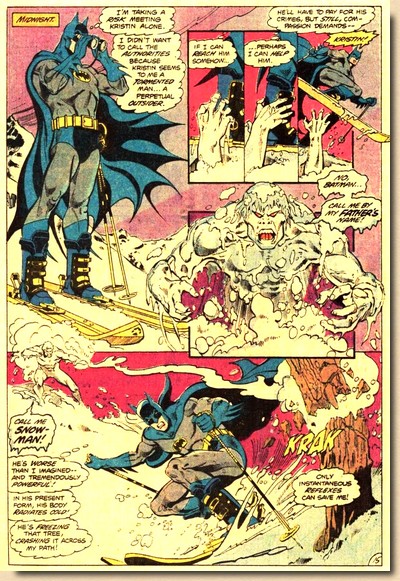
Batman
#337 (July 1981)
|
|
APPEARANCES
In Batman
#337, the Snowman goes on a spree
of robberies in Gotham using his
power of command over ice and
snow. Batman soon suspects Klaus
Kristin and follows him to
Austria where the Darknight
Detective and the Snowman clash
on a snow covered mountain side.
Using a flare gun to blind
Kristin - who is also an albino
and thus has very sensitive eyes
- the Snowman plunges to the
depths down below... and
presumably to his certain death.
However,
Batman then discovers a picture
of Klaus Kristin in a travel
magazine showing him on a
trekking tour in the Himalajas -
and thus obviously still alive (Detective
Comics #522, January 1983).
Travelling to Tibet, the Batman
finds Kristin but also encounters
his Yeti father. This time, the
outcome seems fatal for Kristin
beyond a doubt as he is dying of
a shotwound, although there is
room for doubt as he is carried
away and off into the big white
nothingness of the Tibetan
mountains by his very own father.
The
second time around, death does,
however, seem to have been final
for Klaus Kristin aka the
Snowman, as he has never appeared
in a Batman book again since
then.
He
did, however, appear one more
time outside the Batman Universe
proper, in Justice League
Adventures #12 (December
2002), where he was a member of a
supervillain team known as the
Cold Warriors, alongside Mr
Freeze, Captain Cold, Killer
Frost, Minister Blizzard, Icicle,
Cryonic Man, and Polar Lord.
|
|
|
|
| |
Possibly
the most striking aspect of The Snowman, however, is the
calm with which Batman witnesses the death of this
villain - not once but twice, and essentially triggered
and caused by the Darknight Detective.
|
| |
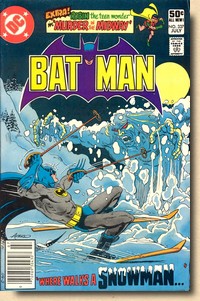 |
|
This is
almost reminiscent of the
earliest appearances of the
Batman in Detective Comics,
where a few gangsters thrown off
rooftops here and there were
nothing special and the Darknight
Detective's bodycount rose to
alarming figures over a very
short period of time. Curtailed in
1940, this typical pulp fiction
attitude was still - if not even
more so - banished in the early
1980s. It would thus seem that
Conway considered a mutant who
leaned more towards his non-human
heritage outside of the
"Batman does not kill, not
even accidentally" rule -
which in a way is a mismatch with
the grains of humanistic
philosophy which Conway weaves
into the dialogue between Batman
and his guide here and there.
Even
though the two appearances of the
Snowman were only 18 months
apart, it would seem that Gerry
Conway didn't quite remember his
own earlier writing as the
location of the Snowman's first
presumed death was changed in a
flashback in Detective Comics
#522 to Switzerland, whereas it
had been Austria in Batman
#337.
|
|
|
|
| |
| |
BATMAN and all
related elements are the property of DC Comics,
Inc. TM and © DC Comics, Inc., a subsidiary of
Time Warner Inc.
The illustrations presented here are copyright
material. Their reproduction for the review and
research purposes of this website is considered
fair use as set out by the Copyright Act of 1976,
17 U.S.C. par. 107.

uploaded to the web 1
November 2015
|
|
|















